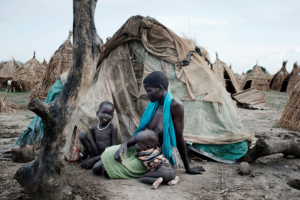Disability and Poverty in Sudan and South Sudan
 Sudan became an independent country in 1956 and South Sudan in 2011. According to the Central Bureau of Statistics, the 1993 Sudan census was the first to document a question about disability within the country. The disability rate at the time was 1.6%. In the 2008 census, the question about disability was more inclusive and approached the “international standard classification of disability,” which revealed that the disability in Sudan increased two and half times more–4.8%.
Sudan became an independent country in 1956 and South Sudan in 2011. According to the Central Bureau of Statistics, the 1993 Sudan census was the first to document a question about disability within the country. The disability rate at the time was 1.6%. In the 2008 census, the question about disability was more inclusive and approached the “international standard classification of disability,” which revealed that the disability in Sudan increased two and half times more–4.8%.
According to the K4D Research Helpdesk (2018), South Sudan’s disability rate was “as high as the global estimate of 15%.” Before the nation’s independence, reports showed that 5.1% of the population was facing disability, but after a clear disability definition and a depletion of the stigma around disability, a 2016 household survey revealed that 15% of South Sudanese households had at least one disabled family member.
Here are 3 NGOs addressing disability and poverty in Sudan and South Sudan to improve the quality of life through education, social, economic and political empowerment of disabled communities.
Action on Disability and Development (ADD) International
ADD International is an NGO that supplies resources and works toward bolstering “disability rights activists and organizations” to effectively make changes in the disabled community at a global scale. It delivers aid to Sudan’s disabled community through the Young Leaders Program. Within this program, young disabled activists receive education about disability law and utilize this knowledge to advocate for change. As a result, many young leaders have culminated with comprehension of their disability rights and have been exposed to other young leaders with a different type(s) of disability which has collectively unified them as a community fighting for the same cause which is disability justice.
The Christian Blind Mission (CBM)
The CBM is an NGO that strives for an all-inclusive world with persons with disabilities in it. It addresses that poverty is the cause and consequence of disability and works to reduce that by helping improve the quality of life of PWDs in the world’s poorest countries. In South Sudan, CBM partnered with the Cartre Centre to change the lives of Robina and Peter, two young leaders with a detrimental cataract disease that can rob them of their sight. CBM immediately covered the costs of the trip, treatment and surgery of the young children, helping them restore their eyesight.
Light for the World
Light for the World is an NGO that amplifies the voices of those with disabilities through inclusive education, access to services and empowerment. The organization has worked in South Sudan since 2007 and partnered with local organizations in the area to accomplish these three goals. In 2021, Light for the World reached at least 5,000 people in South Sudan. More than 300 account children reached out through inclusive education programs and 100 through economic empowerment initiatives.
Bringing Light to the World
It is important to spotlight disability injustice because of the link between disability and poverty. “Persons with disabilities, on average as a group, are more likely to experience adverse socioeconomic outcomes than persons without disabilities,” the World Bank says. Furthermore, people with disabilities are a marginalized group that lacks inclusion, pushing them deeper into poverty.
These three NGOs bring light to the worlds of young, adult, and elderly disabled populations located in the poorest countries because they understand the struggle of those with disabilities and they know that by supplying the disabled community, justice can be served.
– Amy Contreras
Photo: Flickr
